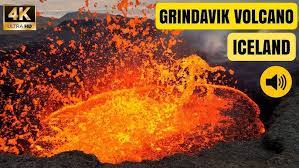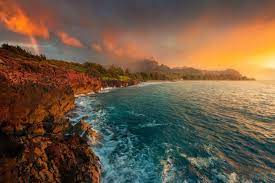Exploring the Volcanic Wonders: A Journey into Fire and Fury

The Power and Beauty of Volcanoes
Volcanoes are one of nature’s most awe-inspiring phenomena. These majestic mountains, formed by the eruption of molten rock from deep within the Earth, have captivated and terrified humans for centuries.
Volcanoes play a crucial role in shaping our planet’s landscape. They create new landmasses, such as islands like Hawaii and Iceland, and contribute to the Earth’s geological processes. While they are often associated with destruction, volcanoes also bring fertility to the soil through the deposition of nutrient-rich volcanic ash.
Despite their destructive potential, volcanoes also hold a certain beauty that is undeniable. The fiery glow of lava flowing down the slopes, the billowing plumes of ash and steam rising into the sky, and the rugged landscapes created by volcanic activity all contribute to their mystique.
Many cultures around the world have revered volcanoes as sacred sites or deities. In Hawaii, for example, Pele is the goddess of fire, lightning, wind, and volcanoes. She is believed to reside in Kilauea, one of the world’s most active volcanoes.
Scientists study volcanoes to better understand their behavior and predict eruptions in order to protect nearby communities. Volcanic monitoring systems have become increasingly sophisticated in recent years, providing valuable data that can help save lives during volcanic emergencies.
Whether viewed from a safe distance or explored up close by brave adventurers, volcanoes continue to fascinate us with their power and beauty. They remind us of nature’s raw force and its ability to both create and destroy with equal intensity.
Understanding Earth’s Fiery Giants: Key Questions About Volcanoes Explained
- What is a volcano?
- How are volcanoes formed?
- What causes a volcano to erupt?
- Are all volcanoes dangerous?
- Can volcanoes be predicted?
- What are the different types of volcanic eruptions?
- How do volcanoes impact the environment?
What is a volcano?
A volcano is a geological formation characterized by a vent or fissure in the Earth’s crust through which molten rock, ash, and gases are expelled during eruptions. These eruptions can vary in intensity, from gentle lava flows to explosive blasts that eject rocks and ash high into the sky. Volcanoes are often found at the boundaries of tectonic plates, where magma from the Earth’s mantle rises to the surface. They play a significant role in shaping the Earth’s surface and are both feared for their destructive potential and admired for their natural beauty.
How are volcanoes formed?
Volcanoes are formed through a process known as volcanic activity, which occurs when molten rock, ash, and gases are expelled from the Earth’s crust through openings in the surface called vents. This molten rock, known as magma, originates from the Earth’s mantle and rises towards the surface due to pressure buildup. As the magma moves upward, it can create chambers beneath the Earth’s surface, leading to the formation of a volcano. When pressure within these chambers becomes too great, it results in an eruption, with lava and volcanic ash being ejected onto the surrounding landscape. Over time, repeated eruptions can build up layers of hardened lava and volcanic debris, shaping the iconic cone-like structure of a volcano that we recognize today.
What causes a volcano to erupt?
A volcano erupts when pressure from gases and molten rock within the Earth’s mantle builds up and forces its way to the surface through a vent or opening in the Earth’s crust. This process is triggered by various factors, such as tectonic plate movement, which can create weak points in the Earth’s crust where magma can escape. Additionally, the composition of the magma, including its temperature, gas content, and viscosity, plays a significant role in determining the explosiveness of a volcanic eruption. When these factors combine and reach a critical point, they result in a volcanic eruption, releasing lava, ash, and gases into the surrounding area.
Are all volcanoes dangerous?
Not all volcanoes are inherently dangerous, as their level of risk largely depends on their activity and location. Some volcanoes are classified as dormant or extinct, meaning they have not erupted in a long time and are not expected to erupt in the near future. These volcanoes pose minimal risk to surrounding areas. However, active volcanoes can be hazardous, with the potential for eruptions that may cause destruction and endanger lives. It is essential to monitor volcanic activity and assess the risks associated with each volcano to ensure the safety of nearby communities and travelers.
Can volcanoes be predicted?
Predicting volcanic eruptions is a complex and challenging task that scientists continually strive to improve. While there are signs and signals that indicate increased volcanic activity, such as seismic activity, gas emissions, and ground deformation, accurately predicting the exact timing and magnitude of an eruption remains elusive. Volcanic monitoring systems have advanced significantly in recent years, providing valuable data for scientists to analyze and make informed forecasts. However, the unpredictable nature of volcanic activity means that eruptions can still occur suddenly and without warning, underscoring the importance of ongoing research and preparedness efforts to mitigate the potential risks associated with volcanic events.
What are the different types of volcanic eruptions?
Volcanic eruptions can vary widely in their intensity and characteristics, leading to different types of volcanic activity. The main types of volcanic eruptions include effusive eruptions, where lava flows steadily from the volcano, explosive eruptions, characterized by violent explosions of ash, gas, and rock fragments, and phreatic eruptions, which occur when water comes into contact with hot volcanic rocks and causes steam-driven explosions. Each type of eruption presents its own set of hazards and impacts on the surrounding environment, highlighting the diverse nature of volcanic activity and the need for careful monitoring and preparedness measures in volcanic regions.
How do volcanoes impact the environment?
Volcanoes have a significant impact on the environment due to their eruption processes. When volcanoes erupt, they release various gases, ash, and lava that can have both short-term and long-term effects on the surrounding ecosystem. The gases emitted during eruptions, such as sulfur dioxide and carbon dioxide, can contribute to air pollution and affect air quality. Volcanic ash can disrupt transportation systems, damage crops, and alter soil fertility. Additionally, volcanic eruptions can lead to changes in climate patterns by releasing large amounts of particles into the atmosphere that can block sunlight and lower temperatures. Overall, the environmental impact of volcanoes underscores the delicate balance between natural forces and ecosystems on Earth.
